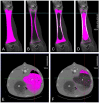Multiparameter growth-performance monitoring of Holstein dairy heifers fed on moderate- or high-energy feeding plans from birth to puberty
- PMID: 39570837
- PMCID: PMC11581270
- DOI: 10.1371/journal.pone.0314015
Multiparameter growth-performance monitoring of Holstein dairy heifers fed on moderate- or high-energy feeding plans from birth to puberty
Abstract
Today, dairy cattle farmers are seeking to optimize expenditure and productivity throughout the lives of their animals by focusing on efficiency at all levels. One strategy for bringing forward the start of a dairy cow's profitability phase is to advance the onset of puberty and reduce the animal's age at their first calving. Thus, one objective of this study was to feed two groups of Holstein dairy heifers the same diet but in different quantities, with the aim of generating a growth differential of at least 200 g/day between the two groups. Thirty-eight heifer calves were followed from birth through puberty using body morphometric measurements and quantitative data collected by automatic feeders, which enabled the monitoring of both feed intake and growth for individual heifers. Routine ultrasonography was used to examine changes in the muscle and adipose tissue compartments, and x-ray tomography was used to monitor bone mineralization and rumen development. At 12 weeks of age, heifers in the optimized feeding (OPT) group had greater cortical bone thickness in the tibia compared with the control (CON) group. At 18 weeks of age, OPT heifers also had more trabecular cancellous bone. In contrast, the ruminal volumes of the heifers in the CON group were greater than those of the OPT heifers at 12 weeks. The OPT heifers had greater indices of general, skeletal, and muscular development at 9 weeks, 6 months, and 12 months. Among the circulating plasma indicators measured in this study, non-esterified fatty acids were highest in the CON calves at 6 and 12 months of age and at the onset of puberty, whereas IGF1 was highest in the OPT calves at all ages. The age at puberty of the OPT calves was 8.4 ± 0.6 months compared with 11.2 ± 1.1 months for the CON calves. The OPT heifers had an average daily weight gain of 1018 g/day from birth to the onset of puberty, which enabled them to achieve increased body fattening and to reach puberty 3 months earlier compared with the CON heifers; the average daily weight gain of the CON heifers was 780 g/day over the same period. Taken together, this study defines new reference values for a multitude of morphometric indicators, thereby enabling precise monitoring of the growth of Holstein heifers from birth to puberty.
Copyright: © 2024 Colas et al. This is an open access article distributed under the terms of the Creative Commons Attribution License, which permits unrestricted use, distribution, and reproduction in any medium, provided the original author and source are credited.
Conflict of interest statement
The authors have declared that no competing interests exist.
Figures



Similar articles
-
Effect of intensified feeding of heifer calves on growth, pubertal age, calving age, milk yield, and economics.J Dairy Sci. 2011 Jul;94(7):3554-67. doi: 10.3168/jds.2010-3923. J Dairy Sci. 2011. PMID: 21700043 Clinical Trial.
-
Short communication: Feeding fat from distillers dried grains with solubles to dairy heifers: III. Effects on posttrial reproductive and lactation performance.J Dairy Sci. 2015 Aug;98(8):5720-5. doi: 10.3168/jds.2014-9164. J Dairy Sci. 2015. PMID: 26074232
-
Differing planes of pre- and postweaning phase nutrition in Holstein heifers: I. Effects on feed intake, growth efficiency, and metabolic and development indicators.J Dairy Sci. 2021 Jan;104(1):1136-1152. doi: 10.3168/jds.2020-18809. Epub 2020 Oct 15. J Dairy Sci. 2021. PMID: 33069415
-
Effect of feeding level pre- and post-puberty and body weight at first calving on growth, milk production, and fertility in grazing dairy cows.J Dairy Sci. 2005 Sep;88(9):3363-75. doi: 10.3168/jds.S0022-0302(05)73020-4. J Dairy Sci. 2005. PMID: 16107427
-
Heifer fertility and carry over consequences for life time production in dairy and beef cattle.Animal. 2014 May;8 Suppl 1:91-104. doi: 10.1017/S1751731114000755. Epub 2014 Apr 3. Animal. 2014. PMID: 24698359 Review.
Cited by
-
The Impact of the Lactation Period Gut Microbiota of Two Different Beef Cattle Breeds on Spring-Born Calves.Animals (Basel). 2025 Jan 13;15(2):197. doi: 10.3390/ani15020197. Animals (Basel). 2025. PMID: 39858197 Free PMC article.
References
-
- Thomas G, Bourrigan X. IDELE-FCEL. Résultats de contrôle laitier. France 2021. Coll: Résultats, IDELE (Ed), Paris, France;2021. p. 1–174.
MeSH terms
LinkOut - more resources
Full Text Sources
Miscellaneous

